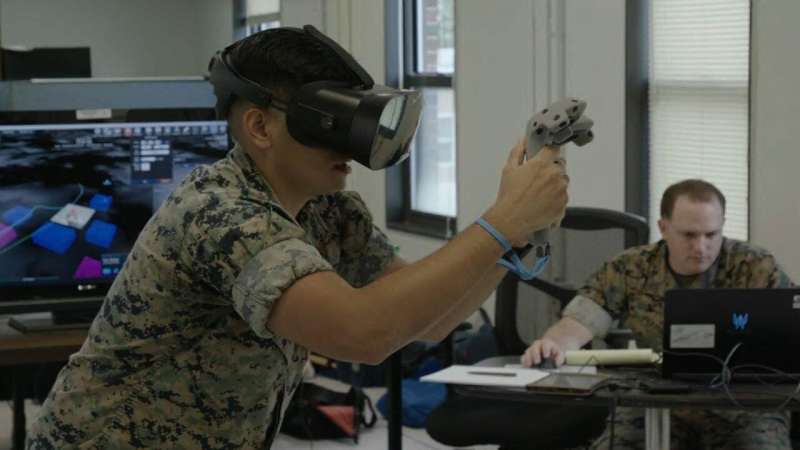Call for fire: ONR tests virtual training systems for JTACs, fire support marines

The Marine scanned the open field and spotted an enemy tank approaching. Using a handheld tablet, he called for an air strike. A helicopter quickly flew in and launched a rocket, destroying the tank.
Removing his goggles, the Marine saw the field remained peaceful and undisturbed. No burning wreckage. The tank was actually a virtual target overlaid onto the landscape, within the viewing display of the Marine's goggles.
The exercise occurred at Marine Corps Base Camp Lejeune, North Carolina, during a demo of two different Office of Naval Research (ONR)-sponsored training systems. Both systems—JTAC Virtual Trainer (JVT) and 3D Warfighter Augmented Reality (WAR)—are designed to make it easier for Joint Terminal Attack Controllers (JTACs) and Fire Support Marines to train.
JTACs and Fire Support Marines support infantry forces by observing the ground situation and calling for necessary air, artillery, mortar or naval gun fire.
Their work requires hours of training and practice to stay proficient. However, getting regular practice time is challenging, since JTACs and Fire Support Marines have to book time in large indoor simulators or participate in live-fire exercises involving expensive ordnance and aircraft.
To make training more mobile and convenient, ONR sponsored the development of JVT and 3D WAR. Both systems come in portable kits and are simple to carry. They use sophisticated, video game-style virtual- and augmented-reality software. And they're made with commercially available equipment.
"When you look at live-fire training, nothing will replace that," said Timothy Parker, a Fires subject matter expert supporting ONR's Warfighter Performance Department. "Unfortunately, ordnance is very costly; you have to schedule time in advance; and, in the case of air, it becomes extremely expensive when you add up that any hour flown means at least two hours of maintenance.
"When you look at other simulators, there are fixed-location sites that provide great training," Parker continued. "But they also require scheduling, a building, a staff. With a system like JVT or 3D WAR, units can train any time and place—within diverse virtual scenarios involving multiple targets."
JVT, developed by tech company Virbela, has video game software in a commercial gaming computer. It features a virtual-reality, head-mounted display that allows JTACs to operate in a fully immersive environment. Hand controllers enable users to interact with virtual equipment and tools used for calling various types of strikes.
"ONR has been fantastic," said Matthew Sedgwick, director, Military and Government, Virbela. "They've sponsored this development effort from pretty much the get-go and allowed us to connect with the Marines to get fast feedback on JVT—what they like and what can be improved."
3D WAR, developed by Lockheed Martin and SRI International, uses augmented-reality (AR) technology to enable Fire Support Marines to see virtual targets, such as vehicles and aircraft, amid real-world settings. It comprises an AR backpack; a head-mounted viewing display with goggles; navigation sensors that track location and feed video to the head-mounted display; and a handheld tablet.
"The advantage of 3D WAR is it allows us to train outdoors in an actual environment using virtual fires," said Colin Sullivan, a Lockheed Martin software engineer. "With most other simulations, you're indoors, you're limited by screens and you don't get as much of an immersive experience as being out in an actual field, working as a team."
"The purpose of developing JVT and 3D WAR is to make training more immersive and engaging," said Dr. Peter Squire, a program officer in ONR's Warfighter Performance Department. "Future training systems need to be easily accessible and useable to Marines—and complement the type of activities they perform during live-fire exercises."




















